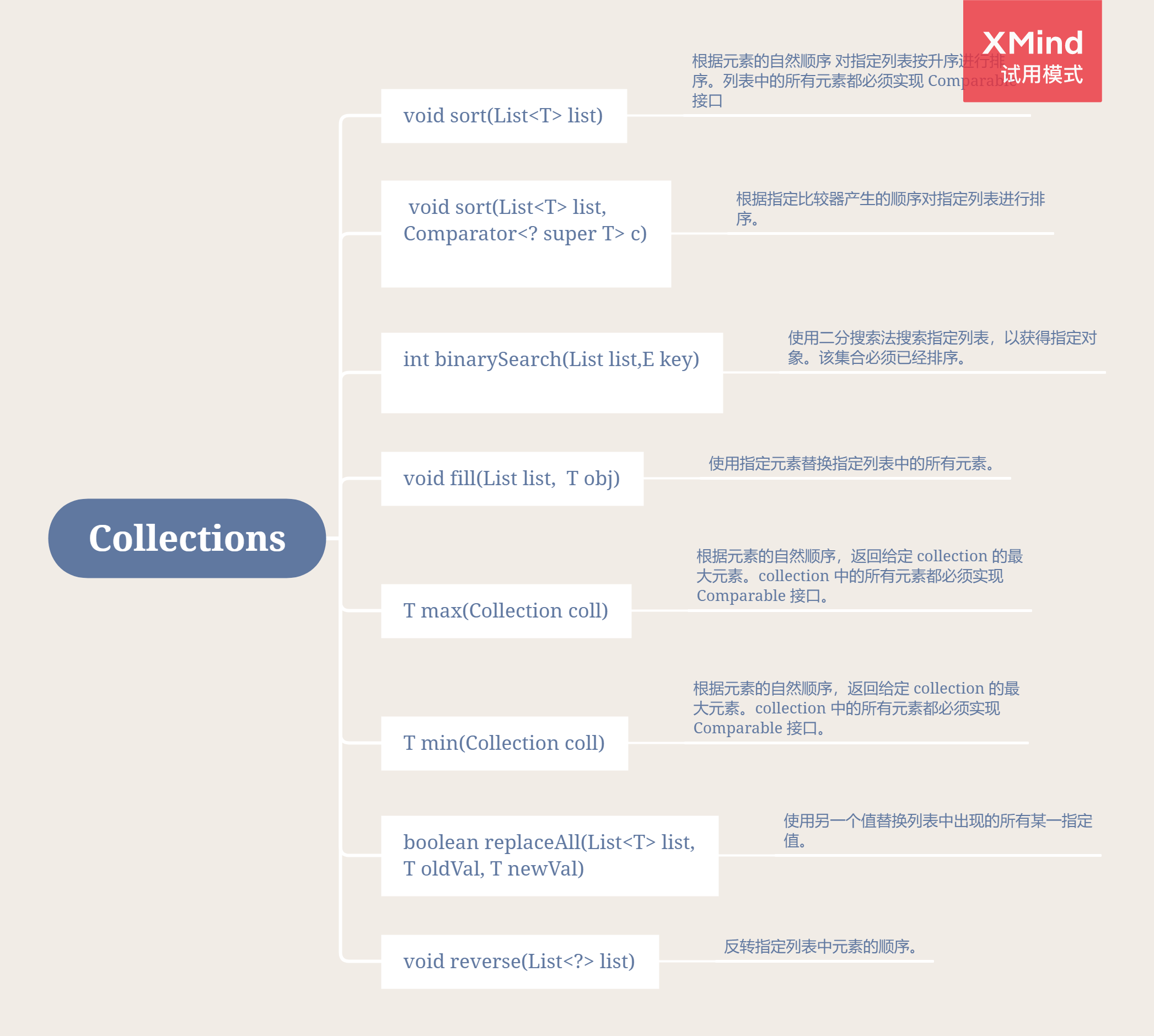java笔记十三——集合的遍历及泛型
一、Collections类
Collections类是单列集合Collection的工具类,Collections工具类为集合提供了许多静态方法,常用方法如下

二、迭代器Iterator
- 在对集合进行迭代的过程中,不要进行增删操作!!!
- 对ArrayList集合中的元素进行修改或删除时,先遍历找到对应元素的索引,遍历结束以后根据索引进行修改或删除
迭代器Iterator是用来遍历Collection集合的,Map集合不能直接使用Iterator迭代器遍历集合元素。
自定义对象并迭代
测试类:
public static void main(String[] args) {
Person p1 = new Person("张三", 20);
Person p2 = new Person("李四", 21);
Person p3 = new Person("王五", 22);
Person p4 = new Person("赵六", 23);
ArrayList<Person> list = new ArrayList<>();
list.add(p1);
list.add(p2);
list.add(p3);
list.add(p4);
Iterator<Person> iterator = list.iterator();
while (iterator.hasNext()) {
Person per = iterator.next();
System.out.println(per);
}
}
Person.java
public class Person {
private String name;
private int age;
public Person() {
}
public String getName() {
return name;
}
public void setName(String name) {
this.name = name;
}
public int getAge() {
return age;
}
public void setAge(int age) {
this.age = age;
}
public Person(String name, int age) {
this.name = name;
this.age = age;
}
@Override
public String toString() {
return "Person{" +
"name='" + name + '\'' +
", age=" + age +
'}';
}
}
三、Map集合的遍历
3.1 keySet()遍历
实现思想:
1、Map接口定义了方法 keySet() ,可以利用这个方法获取Map集合中所有键的Set集合。
2、使用Iterator迭代器遍历Set集合。
3、利用步骤2中获取的key,调用Map集合的get()方法,获取键对应的值。
/**
* - Map接口定义了方法 keySet() 所有的键,存储到Set集合
* - 遍历Set集合
* - 取出Set集合元素 **Set集合的元素是Map集合的键**
* - Map集合方法get()传递键获取值
*/
public static void mapKeySet(){
Map<String,String> map = new HashMap<String, String>();
map.put("a","java");
map.put("b","c++");
map.put("c","php");
map.put("d","python");
map.put("e","erlang");
//Map接口定义了方法 keySet() 所有的键,存储到Set集合
Set<String> set = map.keySet();
//遍历Set集合
Iterator<String> it = set.iterator();
//取出Set集合元素 **Set集合的元素是Map集合的键**
while (it.hasNext()){
String key = it.next();
//Map集合方法get()传递键获取值
String value = map.get(key);
System.out.println(key+"==="+value);
}
}
3.2 entrySet()遍历
实现思想:
1、调用Map接口的方法 Set< Map.Entry<Key,Value> > entrySet()
- 方法返回Set集合,集合中存储的元素,比较特别
- 存储的是Map集合中,键值对映射关系的对象 , 内部接口 Map.Entry
2、利用Iterator迭代器遍历Set集合
3、取出Set集合中的元素
- 是Map.Entry接口对象
- 接口的对象方法: getKey() ,getValue()
public static void mapEntrySet(){
Map<String,String> map = new HashMap<String, String>();
map.put("a","java");
map.put("b","c++");
map.put("c","php");
map.put("d","python");
map.put("e","erlang");
//Map接口的方法 Set< Map.Entry<Key,Value> > entrySet()
Set<Map.Entry<String,String>> set = map.entrySet();
//- 遍历Set集合
Iterator<Map.Entry<String,String>> it = set.iterator();
while (it.hasNext()){
//取出Set集合的元素
Map.Entry<String,String> entry = it.next();
//- 接口的对象方法: getKey() ,getValue()
String key = entry.getKey();
String value = entry.getValue();
System.out.println(key +"==="+ value);
}
}
四、增强for循环
JDK1.5出现的特性 : 循环的特性 (少些代码)
Collection是单列集合的顶级接口,但是到JDK1.5后,为Collection找了个爹
java.lang.Iterable接口 : 实现接口,就可以成为 "foreach"语句的目标
Collection,List,Set都实现了接口,包括数组。
map接口及其子类没有实现该接口。
4.1 for的格式
for(数据类型 变量名 : 集合或者数组){}
- 遍历数组
/**
* for循环遍历数组
* for(数据类型 变量名 : 集合或者数组){}
*/
public static void forArray(){
int[] arr = {1,3,5,7,9};
for(int i : arr){
System.out.println(i+1);
}
System.out.println("arr=="+arr[0]);
}
- 遍历集合
/** for循环遍历集合
*/
public static void forList(){
List<String> list = new ArrayList<>();
list.add("aaa");
list.add("bbb");
list.add("ccc");
for(String s : list){
System.out.println(s);
}
}
五、泛型
5.1 泛型的概念
泛型,即“参数化类型”。一提到参数,最熟悉的就是定义方法时有形参,然后调用此方法时传递实参。那么参数化类型怎么理解呢?顾名思义,就是将类型由原来的具体的类型参数化,类似于方法中的变量参数,此时类型也定义成参数形式(可以称之为类型形参),然后在使用/调用时传入具体的类型(类型实参)。
这样说可能也比较抽象,用一句话总结泛型的作用:强制集合存储固定的数据类型
5.2 泛型的格式
集合类<存储的数据类型> 变量名 = new 集合类<存储的数据类型>();
类型可以不写:钻石操作符
加入泛型后,程序的安全性提高了
public static void main(String[] args) {
/**
* JDK没有泛型技术,就是这样写
* 集合可以存储任何数据类型
* 添加元素的数据类型是Object
*/
List<String> list = new ArrayList<String>();
list.add("a");
list.add(1); //编译错误,数据类型不匹配
Iterator<String> it = list.iterator();
while (it.hasNext()){
String obj =it.next(); //类型转换不需要
System.out.println(obj);
}
}
5.3 泛型的好处
- 安全性提高了
- 程序的代码量减少
- 避免了类型的强制转换
- 程序的问题,由运行时期,提前到编译时期
5.4 自定义泛型类
/**
* 定义类,类名叫工厂
* 自定义泛型类
* Factory<什么都可以写> 只是变量名而已
*/
public class Factory<QQ> {
private QQ q;
public void setQ(QQ q){
this.q = q;
}
public QQ getQ(){
return q;
}
}
public static void main(String[] args) {
//创建对象Factory类对象
// Factory factory = new Factory();//没有泛型,QQ就是Object
Factory<String> factory = new Factory<String>();
factory.setQ("abc");
String s = factory.getQ();
System.out.println(s);
Factory<Double> factory2 = new Factory<Double>();
factory2.setQ(1.5);
Double q = factory2.getQ();
System.out.println(q);
}
5.5 自定义泛型方法
/**
* 泛型的方法,方法参数上
*/
public class Factory<Q> {
/*
* 静态方法
* Q是非静态的, Q的数据类型,是new的时候指定的
*
* 静态方法参数中的泛型,不能和类一样
* 静态方法的泛型,需要在方法上单独定义
* 写在返回值类型的前面
*/
public static <T> void staticMethod(T q){
System.out.println(q);
}
public void print(Q q){
System.out.println(q);
}
}
5.6 泛型接口
1、实现类实现接口,不指定泛型的具体的类型
2、实现类实现接口,指定泛型的具体类型
//泛型接口
public interface Inter <T> {
public abstract void inter(T t);
}
/**
* 实现接口,不理会泛型
* 对象创建的时候,指定类型
*/
public class InterImpl<T> implements Inter<T>{
public void inter(T t){
System.out.println(t);
}
}
/**
* 实现接口,同时指定泛型
*/
public class InterImpl2 implements Inter<String> {
public void inter(String s) {
System.out.println("s=="+s);
}
}
public class GenericTest {
public static void main(String[] args) {
Inter<String> in = new InterImpl<String>();
in.inter("ok");
Inter in2 = new InterImpl2();
in2.inter("kkk");
}
}
5.7 泛型通配符
//泛型的通配符
public class GenericTest {
public static void main(String[] args) {
List<String> stringList = new ArrayList<String>();
stringList.add("abc");
stringList.add("bbc");
List<Integer> integerList = new ArrayList<Integer>();
integerList.add(1);
integerList.add(2);
each(stringList);
each(integerList);
}
/**
* 定义方法,可以同时迭代器 遍历这两个集合
* 方法的参数,是要遍历的集合,不确定是哪个集合
* 定义参数,写接口类型,不要写实现类
*/
public static void each(List<?> list){
Iterator<?> it = list.iterator();
while (it.hasNext()){
Object obj = it.next();
System.out.println(obj);
}
}
}
5.8 泛型限定
泛型限定 : 限制的是数据类型
- 传递E类型或者是E的子类,泛型上限限定 - 传递类型可以是Company或者是他的子类
- 传递E类型或者是E的父类,泛型下限限定
public static void main(String[] args) {
//创建集合,存储员工对象
//开发部的
List<Development> devList = new ArrayList<Development>();
//存储开发部员工对象
Development d1 = new Development();
d1.setName("张三");
d1.setId("开发部001");
Development d2 = new Development();
d2.setName("张三2");
d2.setId("开发部002");
devList.add(d1);
devList.add(d2);
//财务部集合
List<Financial> finList = new ArrayList<Financial>();
Financial f1 = new Financial();
f1.setName("李四");
f1.setId("财务部001");
Financial f2 = new Financial();
f2.setName("李四2");
f2.setId("财务部002");
finList.add(f1);
finList.add(f2);
System.out.println(devList);
System.out.println(finList);
each(devList);
each(finList);
// List<Integer> integerList = new ArrayList<>();
// integerList.add(1);
// each(integerList);
}
/**
* 要求 : 定义方法
* 同时遍历2个集合
* 遍历的同时取出集合元素,调用方法work()
* ? 接收任何一个类型
* 只能接收 Company和子类对象
* 明确父类,不能明确子类
*/
public static void each(List<? extends Company> list){
Iterator<? extends Company> it = list.iterator();
while (it.hasNext()){
//取出元素
Company obj =it.next();
obj.work();
}
}
六、Properties集合
6.2 Properties集合的特点
- 继承Hashtable,实现Map接口
- 底层是哈希表结构
- 线程是安全的,运行速度慢
- 集合没有泛型的写法,键和值的数据类型锁定为String类型
- 集合有自己的特有方法
- 此集合可以和IO流对象结合使用,实现数据的持久化存储
6.3 Properties集合的常用方法
6.3.1 添加获取
public Object setProperty(String key,String value):向集合内添加数据public String getProperty(String key):使用指定的键获取集合中的值
private static void show01() {
// setProperty() 通过该方法向Properties内添加一对字符串键值对
Properties properties = new Properties();
properties.setProperty("kelvin", "180");
properties.setProperty("jack", "168");
properties.setProperty("siri", "170");
// stringPropertyNames() 通过该方法获取Properties集合内的所有键组成的set集合
Set<String> strings = properties.stringPropertyNames();
for (String key : strings) {
String value = properties.getProperty(key);
System.out.println(key + "--" + value);
}
}
6.3.2 store()方法持久化集合数据
public void store(OutputStream out,String comments):将此 Properties 表中的属性列表(键和元素对)写入输出流。
// store() 持久化数据
private static void show02() throws IOException {
/*
持久化数据步骤:
1 创建Properties对象,存储数据
2 创建字节输出流/字符输出流对象,指定将数据持久化的位置(字节流不能持久化中文)
3 调用Properties对象的store()方法,将集合中的临时数据持久化到指定位置
4 释放资源
*/
Properties properties = new Properties();
properties.setProperty("kelvin", "180");
properties.setProperty("jack", "168");
properties.setProperty("siri", "170");
FileWriter fw = new FileWriter("prop.txt");
properties.store(fw, "store data");
fw.close();
}
6.3.3 load()方法加载文件数据到集合
public void load(InputStream inStream):从输入流中读取属性列表(键和元素对)。
/*
加载数据步骤:
1 创建Properties对象
2 调用load方法加载指定文件
3 遍历Properties集合
注意事项:
1 存储键值对的文件中,可以使用=,空格或其他符号进行连接
2 存储键值对的文件中,可以使用#进行注释,注释内容不会加载
3 读取内容默认是字符串格式
*/
private static void show03() throws IOException {
Properties properties = new Properties();
properties.load(new FileReader("prop.txt"));
Set<String> strings = properties.stringPropertyNames();
for (String key : strings) {
String value = properties.getProperty(key);
System.out.println(key + "--" + value);
}
}

